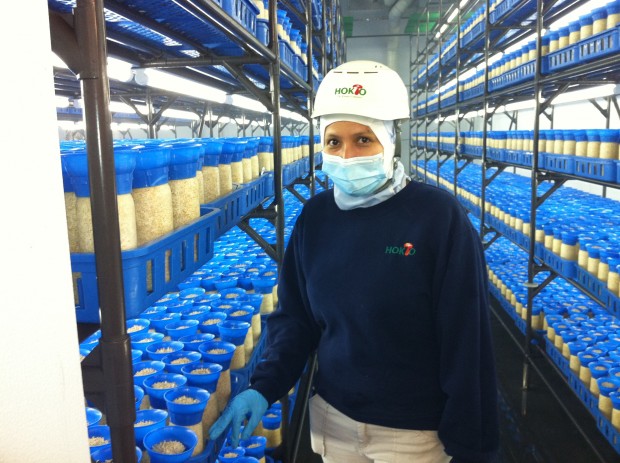
Its mostly sealed, sterile environment and automated processes make the 200,000-square-foot building a farm-in-a-box, largely independent of local labor costs, rainfall, air temperature, or any of the other factors that usually determine the where and when of agriculture.
"Our mushrooms are grown inside so it really doesn't matter where we are. Even in cooler location or much hotter location, it doesn't matter, we just change the parameter," said Katsumi Shigeta, president and CEO of Hokto-Kinoko Co., the plant's owner.
The 200,000 square-foot building houses a temperature-controlled, humidified, mushroom production line that at maximum capacity could crank out 6 million pounds of mushrooms a year in four different varieties.
It relies on robot arms and a computer controlled environment to maximize mushroom growth. It's the only such mushroom factory in the nation, Shigeta said.
Hokto-Kinoko's customers are mostly Asians in North America, but that group has helped the company grow 20 to 30 percent a year since 2009.
Hokto came to San Marcos when Kinoko, a company that imported mushrooms from Hokto Japan, went out of business.
Hokto Japan bought Kinoko's land, formed Hokto-Kinoko, and built its factory, starting production with 30 workers. It now employs at least 120 people, depending on demand for its white beach, brown beech, king trumpet, and maitake mushrooms.
Mushrooms are a touchy crop: They need a particular balance of light, temperature and humidity to grow quickly. They reproduce via thousands of tiny spores, which makes them extremely susceptible to contamination from dust, pollen or even spores from other mushrooms.
Many of the rooms at Hokto's plant required workers and visitors to wear masks, head coverings, and heavy rubber galoshes over their shoes. Other rooms simply required workers to rinse their shoes in a basin of water before entering.
The production process begins with a mixture of corn, soy and other ingredients that form a soil for the mushrooms. Workers pour bags of the ingredients down a chute from a second-floor storage area to the first floor, where a machine mixes, bottles, and caps them. The "growing media" is then sterilized in a 240 degree oven for four hours.
In the next stage, which takes place in sterile "clean room," a robot inserts a portion of a mother mushroom, called the mycelium, which grows into the full plant. Mushrooms can spawn from a part of a mother plant for many generations.
once the mushrooms are introduced, they spend from a few weeks to a few months incubating, depending on the variety.
When they're ready, the small growths will be ready for "buna:" an essential scratching process in which trays of bottles travel along a conveyor belt where another machine runs stiff-bristled brushes across the mycelia.
"It wakes them up, and tells them its time to grow," said Naery Nurse, food safety officer for the plant.
They then live in temperature-controlled refrigerators while they grow to production size. The long rooms that house the juvenile mushrooms become foggy with the spores they're releasing into the air.
When the mushrooms are ripe, pallets of mushrooms are put onto a harvest machine that extracts the mushrooms and, in three of the four varieties, bags them without ever being touched by human hands.
King trumpet mushrooms are too fragile for machine bagging and must be hand bagged, one of the more labor intensive parts of the whole production process.
Workers spend most of their time checking the work of the machines, cleaning, and moving palates of mushrooms from one part of the process to another.
The end product is organic and locally grown, a key selling point to Asian customers. Chinese and Korean exports form Hokto's primary competition. Despite having to fly the mushrooms thousands of miles, they're cheaper than Hokto's organic product.
But those mushrooms have to be sprayed with pesticide in order to be allowed to make the journey overseas.
"When I open the bag of an Asian import, then I smell chemical," Shigeta, the CEO, said, grimacing at the thought.
Production at the San Marcos plant has been growing quickly, but Shigeta said he would like to expand more into the non-Asian American market. Americans shy away from unusual foods, but he hopes that by publishing recipes and making his product available in non-Asian groceries such as Sprouts and Whole Foods, he'll be able to expand his customer base.
"It takes a long time for us to educate," Shigeta said.
























